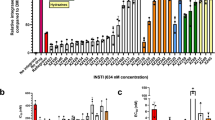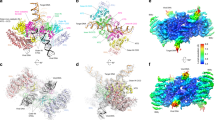Abstract
Integrase is an essential retroviral enzyme that binds both termini of linear viral DNA and inserts them into a host cell chromosome. The structure of full-length retroviral integrase, either separately or in complex with DNA, has been lacking. Furthermore, although clinically useful inhibitors of HIV integrase have been developed, their mechanism of action remains speculative. Here we present a crystal structure of full-length integrase from the prototype foamy virus in complex with its cognate DNA. The structure shows the organization of the retroviral intasome comprising an integrase tetramer tightly associated with a pair of viral DNA ends. All three canonical integrase structural domains are involved in extensive protein–DNA and protein–protein interactions. The binding of strand-transfer inhibitors displaces the reactive viral DNA end from the active site, disarming the viral nucleoprotein complex. Our findings define the structural basis of retroviral DNA integration, and will allow modelling of the HIV-1 intasome to aid in the development of antiretroviral drugs.
This is a preview of subscription content, access via your institution
Access options
Subscribe to this journal
Receive 51 print issues and online access
$199.00 per year
only $3.90 per issue
Buy this article
- Purchase on Springer Link
- Instant access to full article PDF
Prices may be subject to local taxes which are calculated during checkout




Similar content being viewed by others
Accession codes
Primary accessions
Protein Data Bank
Data deposits
Atomic coordinates and structure factors have been deposited with the Protein Data Bank under accession codes 3L2Q (Apo), 3L2R (Mg), 3L2S (Mn), 3L2T (Mg/MK0518), 3L2U (Mg/GS9137), 3L2V (Mn/MK0518) and 3L2W (Mn/GS9137) structures. Raw diffraction images are available on request.
References
Craigie, R. in Mobile DNA II (eds Craig, N. L., Craigie, R., Gellert, M. & Lambowitz, A. M.) 613–630 (ASM Press, 2002)
Lewinski, M. K. & Bushman, F. D. Retroviral DNA integration - mechanism and consequences. Adv. Genet. 55, 147–181 (2005)
Dyda, F. et al. Crystal structure of the catalytic domain of HIV-1 integrase: similarity to other polynucleotidyl transferases. Science 266, 1981–1986 (1994)
Nowotny, M., Gaidamakov, S. A., Crouch, R. J. & Yang, W. Crystal structures of RNase H bound to an RNA/DNA hybrid: substrate specificity and metal-dependent catalysis. Cell 121, 1005–1016 (2005)
Davies, D. R., Goryshin, I. Y., Reznikoff, W. S. & Rayment, I. Three-dimensional structure of the Tn5 synaptic complex transposition intermediate. Science 289, 77–85 (2000)
Richardson, J. M., Colloms, S. D., Finnegan, D. J. & Walkinshaw, M. D. Molecular architecture of the Mos1 paired-end complex: the structural basis of DNA transposition in a eukaryote. Cell 138, 1096–1108 (2009)
Jaskolski, M., Alexandratos, J. N., Bujacz, G. & Wlodawer, A. Piecing together the structure of retroviral integrase, an important target in AIDS therapy. FEBS J. 276, 2926–2946 (2009)
Nowotny, M. Retroviral integrase superfamily: the structural perspective. EMBO Rep. 10, 144–151 (2009)
Engelman, A., Mizuuchi, K. & Craigie, R. HIV-1 DNA integration: mechanism of viral DNA cleavage and DNA strand transfer. Cell 67, 1211–1221 (1991)
Cai, M. et al. Solution structure of the N-terminal zinc binding domain of HIV-1 integrase. Nature Struct. Biol. 4, 567–577 (1997)
Eijkelenboom, A. P. et al. The DNA-binding domain of HIV-1 integrase has an SH3-like fold. Nature Struct. Biol. 2, 807–810 (1995)
Li, M., Mizuuchi, M., Burke, T. R. & Craigie, R. Retroviral DNA integration: reaction pathway and critical intermediates. EMBO J. 25, 1295–1304 (2006)
Marchand, C., Maddali, K., Métifiot, M. & Pommier, Y. HIV-1 IN inhibitors: 2010 update and perspectives. Curr. Top. Med. Chem. 9, 1016–1037 (2009)
Summa, V. et al. Discovery of raltegravir, a potent, selective orally bioavailable HIV-integrase inhibitor for the treatment of HIV-AIDS infection. J. Med. Chem. 51, 5843–5855 (2008)
Sato, M. et al. Novel HIV-1 integrase inhibitors derived from quinolone antibiotics. J. Med. Chem. 49, 1506–1508 (2006)
Espeseth, A. S. et al. HIV-1 integrase inhibitors that compete with the target DNA substrate define a unique strand transfer conformation for integrase. Proc. Natl Acad. Sci. USA 97, 11244–11249 (2000)
Valkov, E. et al. Functional and structural characterization of the integrase from the prototype foamy virus. Nucleic Acids Res. 37, 243–255 (2009)
Hare, S. et al. Structural basis for functional tetramerization of lentiviral integrase. PLoS Pathog. 5, e1000515 (2009)
Wang, J. Y., Ling, H., Yang, W. & Craigie, R. Structure of a two-domain fragment of HIV-1 integrase: implications for domain organization in the intact protein. EMBO J. 20, 7333–7343 (2001)
Michel, F. et al. Structural basis for HIV-1 DNA integration in the human genome, role of the LEDGF/P75 cofactor. EMBO J. 28, 980–991 (2009)
Chen, J. C. et al. Crystal structure of the HIV-1 integrase catalytic core and C-terminal domains: a model for viral DNA binding. Proc. Natl Acad. Sci. USA 97, 8233–8238 (2000)
Chen, Z. et al. X-ray structure of simian immunodeficiency virus integrase containing the core and C-terminal domain (residues 50–293)—an initial glance of the viral DNA binding platform. J. Mol. Biol. 296, 521–533 (2000)
Yang, Z. N., Mueser, T. C., Bushman, F. D. & Hyde, C. C. Crystal structure of an active two-domain derivative of Rous sarcoma virus integrase. J. Mol. Biol. 296, 535–548 (2000)
Alian, A. et al. Catalytically-active complex of HIV-1 integrase with a viral DNA substrate binds anti-integrase drugs. Proc. Natl Acad. Sci. USA 106, 8192–8197 (2009)
Esposito, D. & Craigie, R. Sequence specificity of viral end DNA binding by HIV-1 integrase reveals critical regions for protein-DNA interaction. EMBO J. 17, 5832–5843 (1998)
Jenkins, T. M., Esposito, D., Engelman, A. & Craigie, R. Critical contacts between HIV-1 integrase and viral DNA identified by structure-based analysis and photo-crosslinking. EMBO J. 16, 6849–6859 (1997)
Steiniger-White, M., Rayment, I. & Reznikoff, W. S. Structure/function insights into Tn5 transposition. Curr. Opin. Struct. Biol. 14, 50–57 (2004)
Bujacz, G. et al. Binding of different divalent cations to the active site of avian sarcoma virus integrase and their effects on enzymatic activity. J. Biol. Chem. 272, 18161–18168 (1997)
Nowak, M. G., Sudol, M., Lee, N. E., Konsavage, W. M. & Katzman, M. Identifying amino acid residues that contribute to the cellular-DNA binding site on retroviral integrase. Virology 389, 141–148 (2009)
Miller, M. D., Bor, Y. C. & Bushman, F. Target DNA capture by HIV-1 integration complexes. Curr. Biol. 5, 1047–1056 (1995)
Grobler, J. A. et al. Diketo acid inhibitor mechanism and HIV-1 integrase: implications for metal binding in the active site of phosphotransferase enzymes. Proc. Natl Acad. Sci. USA 99, 6661–6666 (2002)
Langley, D. R. et al. The terminal (catalytic) adenosine of the HIV LTR controls the kinetics of binding and dissociation of HIV integrase strand transfer inhibitors. Biochemistry 47, 13481–13488 (2008)
Buzón, M. J. et al. The HIV-1 integrase genotype strongly predicts raltegravir susceptibility but not viral fitness of primary virus isolates. AIDS 24, 17–25 (2010)
Grobler, J. A., Stillmock, K., Miller, M. D. & Hazuda, D. J. Mechanism by which the HIV integrase active-site mutation N155H confers resistance to raltegravir. Antivir. Ther. 13 (suppl. 3). A41 (2008)
Engelman, A., Hickman, A. B. & Craigie, R. The core and carboxyl-terminal domains of the integrase protein of human immunodeficiency virus type 1 each contribute to nonspecific DNA binding. J. Virol. 68, 5911–5917 (1994)
Cherepanov, P. LEDGF/p75 interacts with divergent lentiviral integrases and modulates their enzymatic activity in vitro . Nucleic Acids Res. 35, 113–124 (2007)
Leslie, A. G. W. Recent changes to the MOSFLM package for processing film and image plate data. Joint CCP4 and ESF-EAMCB Newsletter on Protein Crystallography no. 26, (1992)
Collaborative Computational Project, Number 4. The CCP4 suite: programs for protein crystallography. Acta Crystallogr. D 50, 760–763 (1994)
McCoy, A. J. et al. Phaser crystallographic software. J. Appl. Crystallogr. 40, 658–674 (2007)
Terwilliger, T. C. SOLVE and RESOLVE: automated structure solution and density modification. Methods Enzymol. 374, 22–37 (2003)
Cowtan, K. The Buccaneer software for automated model building. 1. Tracing protein chains. Acta Crystallogr. D 62, 1002–1011 (2006)
Emsley, P. & Cowtan, K. Coot: model-building tools for molecular graphics. Acta Crystallogr. D 60, 2126–2132 (2004)
Zwart, P. H. et al. Automated structure solution with the PHENIX suite. Methods Mol. Biol. 426, 419–435 (2008)
Murshudov, G. N., Vagin, A. A. & Dodson, E. J. Refinement of macromolecular structures by the maximum-likelihood method. Acta Crystallogr. D 53, 240–255 (1997)
Winn, M. D., Isupov, M. N. & Murshudov, G. N. Use of TLS parameters to model anisotropic displacements in macromolecular refinement. Acta Crystallogr. D 57, 122–133 (2001)
Davis, I. W. et al. MolProbity: all-atom contacts and structure validation for proteins and nucleic acids. Nucleic Acids Res. 35, W375–W383 (2007)
Schüttelkopf, A. W. & van Aalten, D. M. PRODRG: a tool for high-throughput crystallography of protein-ligand complexes. Acta Crystallogr. D 60, 1355–1363 (2004)
Gouet, P., Robert, X. & Courcelle, E. ESPript/ENDscript: Extracting and rendering sequence and 3D information from atomic structures of proteins. Nucleic Acids Res. 31, 3320–3323 (2003)
Lee, B. & Richards, F. M. The interpretation of protein structures: estimation of static accessibility. J. Mol. Biol. 55, 379–400 (1971)
Luscombe, N. M., Laskowski, R. A. & Thornton, J. M. NUCPLOT: a program to generate schematic diagrams of protein-nucleic acid interactions. Nucleic Acids Res. 25, 4940–4945 (1997)
Acknowledgements
We thank F. Dyda for critical reading of the manuscript, R. Clayton and M. Cummings for the generous gift of InSTIs and helpful discussions, T. Sorensen and the staff of the I02 and I04 beamlines of the Diamond Light Source for assistance with X-ray data collection. P.C. and co-workers are funded by the UK Medical Research Council, and A.E. by the US National Institutes of Health.
Author Contributions E.V. and P.C. carried out initial trials with truncated PFV IN constructs; S.S.G. and P.C. obtained full-length PFV IN–DNA complexes, carried out crystallization screening and optimization; S.H. soaked and prepared crystals for data collection; S.H. and P.C. collected diffraction data and solved the structures; S.H. refined the final models; S.H. and S.S.G. carried out gel-filtration and activity assays; P.C., S.H. and A.E. wrote the paper.
Author information
Authors and Affiliations
Corresponding author
Supplementary information
Supplementary Information
This file contains Supplementary Table 1 and Supplementary Figures 1-7 with Legends. (PDF 5518 kb)
Supplementary Movie 1
This movie file shows the overall architecture of the PFV intasome. (MOV 10871 kb)
Rights and permissions
About this article
Cite this article
Hare, S., Gupta, S., Valkov, E. et al. Retroviral intasome assembly and inhibition of DNA strand transfer. Nature 464, 232–236 (2010). https://doi.org/10.1038/nature08784
Received:
Accepted:
Published:
Issue Date:
DOI: https://doi.org/10.1038/nature08784
This article is cited by
-
Insight into the molecular mechanism of the transposon-encoded type I-F CRISPR-Cas system
Journal of Genetic Engineering and Biotechnology (2023)
-
DNA strand breaks and gaps target retroviral intasome binding and integration
Nature Communications (2023)
-
A proteomic screen of Ty1 integrase partners identifies the protein kinase CK2 as a regulator of Ty1 retrotransposition
Mobile DNA (2022)
-
A clinical review of HIV integrase strand transfer inhibitors (INSTIs) for the prevention and treatment of HIV-1 infection
Retrovirology (2022)
-
Structure and function of retroviral integrase
Nature Reviews Microbiology (2022)
Comments
By submitting a comment you agree to abide by our Terms and Community Guidelines. If you find something abusive or that does not comply with our terms or guidelines please flag it as inappropriate.



